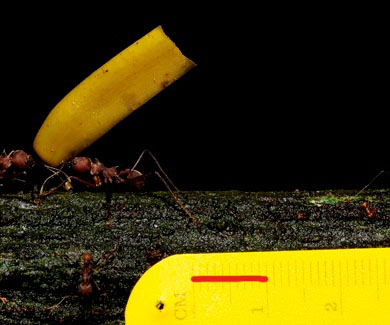We are going to use image analysis to help us learn about these amazing leaf cutter ants. Image analysis, in the most general sense, just means obtaining information from images. In modern scientific parlance, image analysis refers to using computer software to collect data from images. The images may be obtained from satellites, cameras, imaging technology like CAT or MRI scans, or microscopes. The data may be presence/absence, counts, or measurements of lengths, volumes, or areas. Image analysis is thus a very general tool used by scientists in many disciplines.
Because image analysis is so useful, the National Institutes of Health (NIH) funded the development of free image analysis software, now called ImageJ. ImageJ is very powerful, and luckily for us, very simple to use.
 The logic of measuring from images is simple - the computer can count pixels in an image, and if we know how many pixels equates to a centimeter, for example, we can measure things in centimeters. This requires us to either include a scale bar in our image, or to know the precise dimensions of the image captured by the camera. Here we will use scale bars:
The logic of measuring from images is simple - the computer can count pixels in an image, and if we know how many pixels equates to a centimeter, for example, we can measure things in centimeters. This requires us to either include a scale bar in our image, or to know the precise dimensions of the image captured by the camera. Here we will use scale bars:
If the red line in the picture to the left is 140 pixels long, for example, we would then know there are 140 pixels per centimeter, and thus if we were to measure an ant's total length to be 280 pixels, how long would it be in centimeters? Yep, 2 cm.
NEXT->Because image analysis is so useful, the National Institutes of Health (NIH) funded the development of free image analysis software, now called ImageJ. ImageJ is very powerful, and luckily for us, very simple to use.
 The logic of measuring from images is simple - the computer can count pixels in an image, and if we know how many pixels equates to a centimeter, for example, we can measure things in centimeters. This requires us to either include a scale bar in our image, or to know the precise dimensions of the image captured by the camera. Here we will use scale bars:
The logic of measuring from images is simple - the computer can count pixels in an image, and if we know how many pixels equates to a centimeter, for example, we can measure things in centimeters. This requires us to either include a scale bar in our image, or to know the precise dimensions of the image captured by the camera. Here we will use scale bars:If the red line in the picture to the left is 140 pixels long, for example, we would then know there are 140 pixels per centimeter, and thus if we were to measure an ant's total length to be 280 pixels, how long would it be in centimeters? Yep, 2 cm.
image analysis basics image analysis instructions hypothesis formation regression basics regression instructions post-lab bibliography
image and video sets regression practice